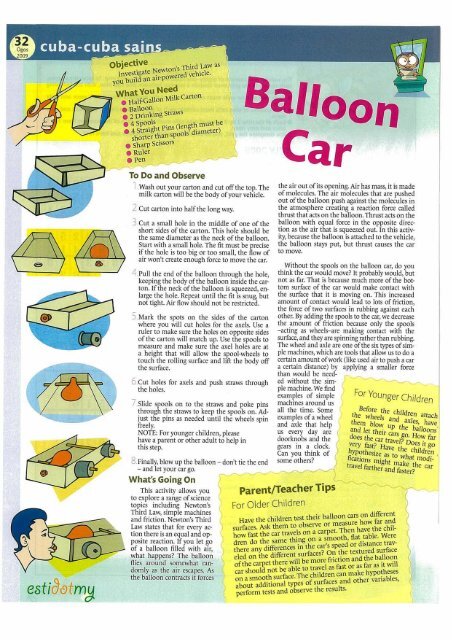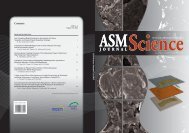Teknologi Hijau - Akademi Sains Malaysia
Teknologi Hijau - Akademi Sains Malaysia
Teknologi Hijau - Akademi Sains Malaysia
You also want an ePaper? Increase the reach of your titles
YUMPU automatically turns print PDFs into web optimized ePapers that Google loves.
Objective<br />
Investig<br />
you build ate<br />
esfi , m 3<br />
as<br />
an air Ne-tipooVeredhvehicle.<br />
What You Need<br />
• Half-Gallon Milk Carton<br />
• Balloon<br />
• 2 Drinking Straws<br />
Spools<br />
• 4 Straight Pins (length<br />
shorter than sp<br />
• Sharp Scissors<br />
• Ruler<br />
• Pen<br />
To Do and Observe<br />
h must be<br />
1 Wash out your carton and cut off the top. The<br />
milk carton will be the body of your vehicle.<br />
/Cut carton into half the long way.<br />
3.Cut a small hole in the middle of one of the<br />
short sides of the carton. This hole should be<br />
the same diameter as the neck of the balloon.<br />
Start with a small hole. The fit must be precise<br />
if the hole is too big or too small, the flow of<br />
air won't create enough force to move the car.<br />
4.Pull the end of the balloon through the hole,<br />
keeping the body of the balloon inside the carton.<br />
If the neck of the balloon is squeezed, enlarge<br />
the hole. Repeat until the fit is snug, but<br />
not tight. Air flow should not be restricted.<br />
5.Mark the spots on the sides of the carton<br />
where you will cut holes for the axels. Use a<br />
ruler to make sure the holes on opposite sides<br />
of the carton will match up. Use the spools to<br />
measure and make sure the axel holes are at<br />
a height that will allow the spool-wheels to<br />
touch the rolling surface and lift the body off<br />
the surface.<br />
C.Cut holes for axels and push straws through<br />
the holes.<br />
.Slide spools on to the straws and poke pins<br />
through the straws to keep the spools on. Adjust<br />
the pins as needed until the wheels spin<br />
freely.<br />
NOTE: For younger children, please<br />
have a parent or other adult to help in<br />
this step.<br />
8.Finally, blow up the balloon - don't tie the end<br />
- and let your car go.<br />
What's Going On<br />
This activity allows you<br />
to explore a range of science<br />
topics including Newton's<br />
Third Law, simple machines<br />
and friction. Newton's Third<br />
Law states that for every action<br />
there is an equal and opposite<br />
reaction. If you let go<br />
of a balloon filled with air,<br />
what happens? The balloon<br />
flies around somewhat randomly<br />
as the air escapes. As<br />
the balloon contracts it forces<br />
the air out of its opening. Air has mass, it is made<br />
of molecules. The air molecules that are pushed<br />
out of the balloon push against the molecules in<br />
the atmosphere creating a reaction force called<br />
thrust that acts on the balloon. Thrust acts on the<br />
balloon with equal force in the opposite direction<br />
as the air that is squeezed out. In this activity,<br />
because the balloon is attached to the vehicle,<br />
the balloon stays put, but thrust causes the car<br />
to move.<br />
Without the spools on the balloon car, do you<br />
think the car would move? It probably would, but<br />
not as far. That is because much more of the bottom<br />
surface of the car would make contact with<br />
the surface that it is moving on. This increased<br />
amount of contact would lead to lots of friction,<br />
the force of two surfaces in rubbing against each<br />
other. By adding the spools to the car, we decrease<br />
the amount of friction because only the spools<br />
-acting as wheels-are making contact with the<br />
surface, and they are spinning rather than rubbing.<br />
The wheel and axle are one of the six types of simple<br />
machines, which are tools that allow us to do a<br />
certain amount of work (like used air to push a car<br />
a certain distance) by<br />
than would be needed<br />
without the simple<br />
machine. We find<br />
examples of simple<br />
machines around us<br />
all the time. Some<br />
examples of a wheel<br />
and axle that help<br />
us every day are<br />
doorknobs and the<br />
gears in a clock.<br />
Can you think of<br />
some others?<br />
Parent/Teacher Tips<br />
For Older Children<br />
applying a smaller force<br />
For Younger Children<br />
Before the children attach<br />
the wheels and axles, have<br />
them blow up the balloons<br />
and let their cars go. How far<br />
does the car travel? Does it go<br />
very fast? Have the children<br />
hypothesize as to what modications<br />
might make the car<br />
travel farther and faster?<br />
Have the children test their balloon cars on different<br />
surfaces. Ask them to observe or measure how far and<br />
how fast the car travels on a carpet. Then have the children<br />
do the same thing on a smooth, flat table. Were<br />
there any differences in the car's speed or distance traveled<br />
on the different surfaces? On the textured surface<br />
of the carpet there will be more friction and the balloon<br />
car should not be able to travel as fast or as far as it will<br />
on a smooth surface. The children can make hypotheses<br />
about additional types of surfaces and other variables,<br />
perform tests and observe the results.

















